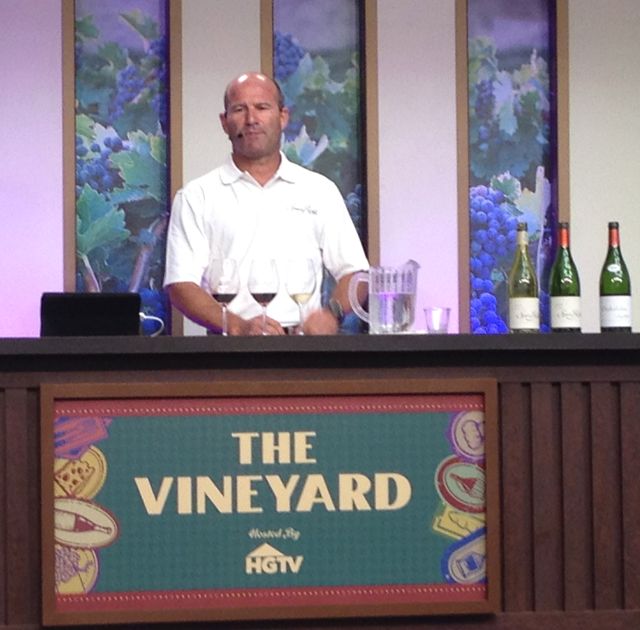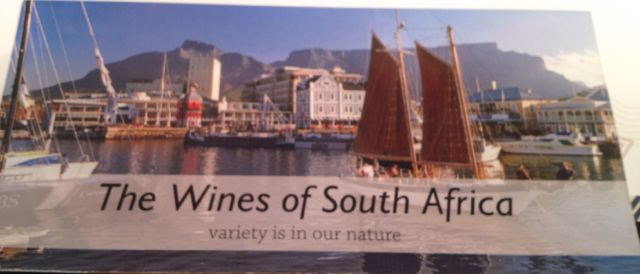Spice Route Wines, Swartland, South Africa
Chenin Blanc, Pinotage, and Chakalaka
October 2, 2012
We’ve had all of these Spice Route wines before; at Jiko with Lisa and Andy (Chakalaka), at a culinary demonstration during last year’s Epcot Food & Wine Festival (Pinotage, here), and just two days ago at a different culinary demonstration (Chenin Blanc, here). And thus, we’ve seen Charl before (although nora misidentified him and then misspelled his name – corrected now).
On to the learning…
“Swartland” means “black” land in Afrikans and is located in South Africa. There is a great variety of geographies in South Africa, and thus there is a great variety of wine. Swartland has very low rainfall (about 450 mm per year, for those of us who don’t “think in metric” that’s less than 18 inches per year) and it is very hot. The soil is critical as it must retain moisture for nearly 9 months between rainy seasons, and Spice Route wine growers do not use irrigation. The vines aren’t the trellis vineyards that most of us are used to seeing, they are bush vines… low to the ground; due to the growing conditions, the vines produce a lot less fruit (40% of what trellis vines usually produce)… but what is produced tends to have more concentrated flavors. “Ground cover” is planted between the rows to help retain moisture. The climate and soil profile of Swartland is very similar to the Mediterranean and the south of France, thus the wines are most similar to these sorts of wine.
There are two predominant soils – “oak leaf” and “koffeklip”. Two soils –> two wines. The vintner blends these to make perfect wines.
The winemaker plays only a small part – soil and grape are the real players.
The owners of Spice Route, Goats du Rhome, and Fairview (Charles Back and Family) transformed a tobacco farm into a vineyard = Spice Route. Charl uses both french and american oak. Interestingly, they also produced goat cheese… they’re the biggest producer in South Africa. And lastly, Spice Route has recently added a tasting room and a restaurant.
A few more facts and then it’s on to the tasting!
- Can’t really make a low alcohol wine from South Africa because of the heat and how it affects grape growth.
- South Africa has been producing wines for about 300 years, there are a lot of European influences in South African wine because that’s where the genesis training was obtained.
- All of Spice Routes white wines have a screw cap. Why? Because they can bottle the wine with less sulfur if it is screw capped instead of corked.
- Most wine producers pay for grapes by weight; Charl doesn’t, they contract with the grower’s for that season’s crop. That’s what the grower gets paid for and that’s what the producer gets.
- A lot of Spice Route’s production ends up at Disney World! (Jiko and Sanaa)
Spice Route Chenin Blanc 2011
- This white wine vintage is peaking right now, after 2014 it will be not be very drinkable.
- Tasting Notes read… spiced apple with modern light oaking, creamy mouth feel, lingering pineapple finish
- 13.5% ABV, 20% less sulfur than non-screw-cap white wines; and thanks to the screw cap, it will keep refrigerated for up to 7 days
- Comes from a single vineyard block (about 35 years old), koffestone soil
- nora’s notes: apple nose and taste is not bad
- About $19 per bottle
Spice Route Pinotage
- In general, people sort of expect pinotage to have aromas and flavors of burnt rubber or tar – this pinotage does not
- Open fermentation and aging in 100% American Oak make this pinotage special
- Tasting Notes read… riper plum/raspberry nose, medium bodied and good structure, sweet/smokey cherry tobacco
- Charl recommends that this is a good barbecue wine, pairs well with things like steak and grilled ribs
- nick’s notes: I can imagine that this would be good with any red meat from the grill, no way I could drink this without food, but think it would be very good grilled food
- nora’s notes: red fruit, sweet smoky finish, agree that it would be really good with grilled meat
- Expect $27 per bottle
Spice Route Chakalaka
- Every vintage of Chakalaka has received 90+ from Wine Spectator
- Chakalaka means “a relish or concoction, blend of different spices” and what Charl has done is create a blended wine – blend of grapes from both soils, 6 different vineyard blocks
- Tasting Notes read… smokey cloves/plum/black cherry, medium body with oak and fruit, lingering spice flavors
- Uses 40% American Oak (first fermentation for 12-14 months) and 60% French Oak (blended and then aged in this for another 18? months)
- nick’s notes: smelled best to me, but tastes strong/forward, might be able to drink without food (the other 2, no way)
- nora’s notes: I still like Chakalaka, it has a bit of chalkiness which I like in a red wine



